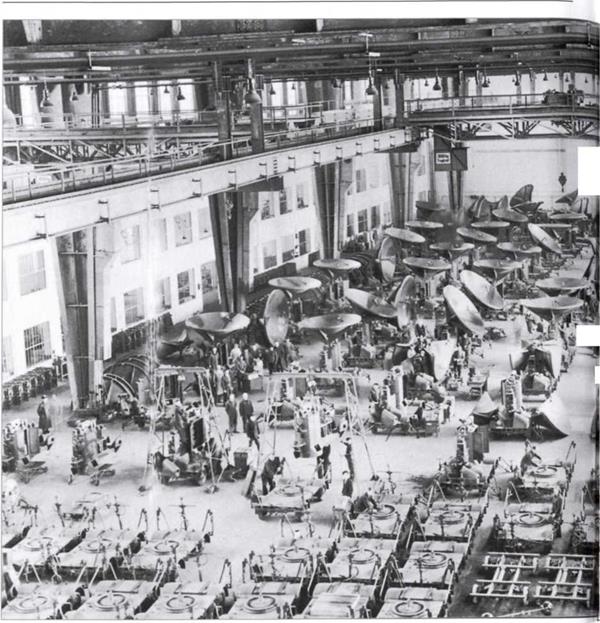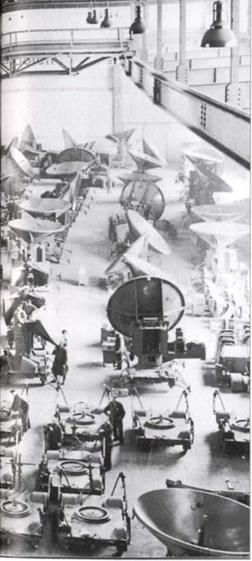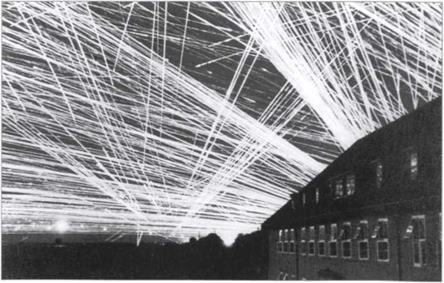Night Fighters?
|
T |
owards the end of the 1944, the German night-fighter arm was in crisis.
The efficient He 219 had not been introduced in numbers. Problems also persisted with on-board radar. From 1945 some units could expect to receive more high performance piston aircraft, or Me 262 and Ar 234 jets. Well – equipped night- and all-weather fighters were already under construction, but few thought the time would come when they would be flown.
Radar
Ever larger formations of RAF night bombers over the Reich in 1944 had asked a lot of the night-fighter arm. The Bf 110 and Do 217, and increasingly the Ju 88 G-l and G-6 were too slow and their radar equipment inadequate. The German
|
The increasingly heavy air attacks of the RAF and American bomber fleets forced Germany constantly to increase flak artillery. |

command centres, and individual crews, knew how susceptible the radar was to chaff and powerful jamming techniques at which the enemy excelled. Even the most modern versions of the once highly praised FuG 220 Lichtenstein were experiencing interference across the wavebands. Since Allied equipment used centimetric frequencies, all later Ju 88 G-6 night fighters were equipped with an FuG 350Zb to detect this range and so obtain advance warning of the arrival of enemy bombers.
The workshops of Deutsche Lufthansa also handled assembly work of the Wurzburg radar during the war.
 The real improvement occurred at the end of 1944 when, after a long and technically difficult phase of research and testing, the first centimetric sets began to filter through to operational units. These were modern 9-cm FuG 240 and FuG 244 radars. Their disguised parabola aerial was fitted alongside the conspicuously long aerials of the SN-2 unit at the nose. The bearing of the target was indicated by a tube on the FuG 240/1 Berlin N1 using a frequency around 3,500 MHz with a maximum range of 9,000 metres; 25 of the order for 100 of these Telefunken devices were delivered by the end of March 1945 and ten installed in Ju 88 G-6s of III./NJG 2 operating from Giitersloh. The unit had a working range of 5,000 metres down to 350 metres, and produced more precise data than the SN-2. The FuG 240/2 was similar to the Berlin N1 but had an improved panoramic screen showing successive sectors. Two different variants, Berlin D1 and D2, were under development, their frequencies ranging from 8,350 to 9,400 MHz.
The real improvement occurred at the end of 1944 when, after a long and technically difficult phase of research and testing, the first centimetric sets began to filter through to operational units. These were modern 9-cm FuG 240 and FuG 244 radars. Their disguised parabola aerial was fitted alongside the conspicuously long aerials of the SN-2 unit at the nose. The bearing of the target was indicated by a tube on the FuG 240/1 Berlin N1 using a frequency around 3,500 MHz with a maximum range of 9,000 metres; 25 of the order for 100 of these Telefunken devices were delivered by the end of March 1945 and ten installed in Ju 88 G-6s of III./NJG 2 operating from Giitersloh. The unit had a working range of 5,000 metres down to 350 metres, and produced more precise data than the SN-2. The FuG 240/2 was similar to the Berlin N1 but had an improved panoramic screen showing successive sectors. Two different variants, Berlin D1 and D2, were under development, their frequencies ranging from 8,350 to 9,400 MHz.
The N2 and N3 centimetric-waveband equipment never left the laboratories and FuG 240/4 Berlin N4 was produced in 1945 as a contact keeper for wide-ranging night operations or long-distance chases. FuG 244 Bremen 0 had a powerful beam transmitter for the longer ranges to be expected in future. The equipment was fighter and more compact than the Berlin series and was scheduled to replace SN-2 radar within a few months, but a reported problem was masking of the field by the tailplane and wings. The single set of 100 ordered was at Diepensee under test early in April 1945.
Relatively few Ju 88 G-6s were fitted experimentally with Berlin N1 radar from the end of 1944 for operations over northern Germany. Their use contributed to ten RAF aircraft shot down by the end of March 1945. A few
others from the Gruppenstabe at I. and II./NJG 4 also carried the FuG 240. This provided the Luftwaffe with an on-board radar of equal value to Allied developments in the night-fighter sphere, supplemented by a system of field observers, air reconnaissance and radar.











